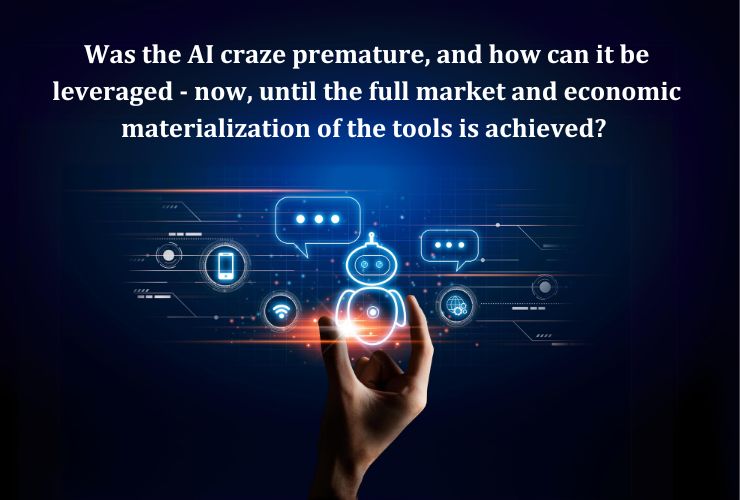During the last year and a half, the AI has become a hot topic – the investors have sensed the potential for a new surge in profits and have invested 2 trillion US dollars in the market value of the top 5 big tech companies during just the past year - which theoretically would mean that projected earnings should be around $300-400bn annually. However, the most optimistic projection shows that Microsoft will only earn $10b from AI this year, claims The Economist. Even with a growth rate of 20% per year, it is believed that the true market effects of investing in AI will only be seen by 2032. However, we have some ideas on where AI could already be used profitably.
Paradoxically, AI is not being adopted fast enough - even though the frenzy around the potential use of AI has quickly engulfed the media and business circles, only 5% of companies have used AI in the past two weeks, and it is predicted that in six months, only 7% of companies will be using AI in any serious sense, says America’s Census Bureau. On the other hand, 75% of companies already use some form of AI, including Google Translate or similar Google tools.
All this raises questions - was the AI craze premature, and how can it be leveraged - now, until the full market and economic materialization of the tools is achieved?

CV cross-analysis
AI mainly serves to speed up some boring and laborious tasks, which, due to their complexity and number of facts, exceed either the power of man or his concentration. One such example that we have encountered and successfully dealt with is the analysis of the skills of candidates and employees through various CVs.
CVs are generally motley in form even when they are in a database that aggregates all CVs. If the company considers that it needs an employee with a certain skill or a certain set of skills, it is necessary to analyse all CVs that have been uploaded to the database by cross-analysis, regardless of whether they are in PDF or Word format - and here the traditional programmes proved ineffective, because it was necessary for all CVs to be uniform in order for the program to recognise and compare employee skills.
The AI-supported programme solves this problem because the program that uses it already at the start uses the "human" feature to ignore document formats and positions of individual categories, but intuitively understands them like a human brain, and compares them quickly like a computer programme. Thus, a manager looking for a candidate in the database can very quickly find a potentially suitable candidate in any part of the world.
User Manual Sublimation and Large Documents Analysis in Highly Regulated Environment
Also, another use of AI-supported programmes is the sublimation of all user instructions, again in a "human intuitive way" - generating a human-understandable "narrative" from a multitude of user instructions that are often very difficult to navigate, voluminous or diverse.
Highly regulated industries have product release processes that include an approval process that varies by project size and the department involved. Each project and/or department within the organisation establishes its own document approbation and distribution processes.
In, the pharmaceutical industry, for instance, during the production process, an extremely large number of reports are generated on the condition of the output products, which must be analysed in real time, and this is a problem known as Large Document Analysis.
Organisations requiring large-scale document analytics can leverage AI-powered solutions to automate approval notifications and create cloud storage processes that automatically distribute newly approved corrections and reminders. They can also streamline approval processes in terms of how they handle disapprovals and resubmissions, and surface only corrections that have not yet been approved for subsequent review.
Where do we go next?
For the AI market, it is projected to grow at a compound annual growth rate (CAGR) of 28.46% from 2024 to 2030, says Hostinger. Markets and Markets claim this figure to be even higher – 35.7% in the same period.
Yet, in spite of all this potential, the specific usage lags the high hopes. If we concentrate on the realm of the possible right now, we can solve many time-consuming problems right now. And accelerate the profit rate.
Ready to take the next step?
Let's explore how our expertise can help you innovate and implement your vision in a digital world.
Reach out to us:ICodeFactory | Contact
